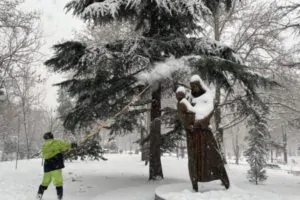
Do winter months leave you wondering how to keep your beloved trees healthy and thriving? Did you know, just like us, trees, too, need extra care during the chilly season to maintain their health.
This article is a comprehensive guide that will equip you with practical steps to protect your trees from freezing temperatures, frostbite, and harsh winds. Read on for insider tips that’ll turn you into a pro tree guardian this winter!
Understanding the Importance of Winter Tree Care
Winter tree care holds great importance for the overall health of your trees. Trees are susceptible to various issues, such as frost damage, disease outbreak, and dehydration during the harsh winter months.

Regular tree spraying and appropriate pruning can help keep these problems at bay.
Applying fertilizer ensures that trees get essential nutrients even during the cold season. Proper understanding of plant nutrition and effective fertilization techniques play a key role in maintaining your garden’s vibrancy throughout winter.
Not only does it aid in strengthening the roots, but it also helps trees withstand the ravages of extreme weather conditions.
Different types of fertilizers serve specific functions; hence, choosing the right one becomes crucial for winter tree care. For instance, mulching is an excellent insulation method that preserves heat and moisture in soil thereby preventing freeze-thaw cycles that may harm your trees’ roots.
Shielding from frost and wind is vital, too. Frost can cause ice crystals to form inside plants, rupturing their cells, while strong winds may break branches or uproot entire trees, if they’re not structurally stable enough due to lack of proper trimming.
Making use of certain barriers like burlap wraps or erecting temporary windbreaks could offer adequate protection against these elements, ensuring your trees remain healthy all year round.
Proper Pruning
You need to know the right way to prune your trees during winter. Here are some important steps:
1. Identify damaged or diseased branches first.
2. Use clean, sharp tools for precise cuts.
3. Make sure to trim branches at their base, not in the middle.
4. Avoid heavy pruning on evergreen plants; they rely on their leaves for protection against winter cold.
5. Don’t forget to prune shrubs and bushes; these also need care and attention.
Mulching for Insulation
Layering the base of your trees with mulch is a practical step in winter tree care. This process offers many benefits, which include:
● Providing a buffer from extreme temperature changes: Mulch acts as an insulator, reducing the impact of harsh weather conditions on the roots.
● Boosting plant nutrition: As organic mulch breaks down, it enriches the soil with vital nutrients, promoting healthier trees.
● Enhancing soil moisture preservation: Mulch locks in water, preventing quick evaporation and maintaining a moist environment for tree roots, even during cold months.
● Combatting weed growth: A layer of mulch suppresses weeds, which if left unchecked could steal crucial nutrients from your trees.
● Use organic materials such as wood chips or straw: These types of mulch not only insulate but also provide important nutrients as they decay.
● Keep a clearance around the tree trunk: Ensure that you leave some space around the base to prevent rot and the invasion of pests.
● Apply an adequate layer of mulch: Generally, a 2 to 4-inch deep layer is optimal for effective insulation.
Shielding from Frost and Wind
To protect your trees from the harsh winter weather, it is important to shield them from frost and wind. Here are some effective ways to do so:
● Wrap the trunks: Using a tree wrap or burlap, wrap the trunks of your trees to protect them from freezing temperatures and strong winds.
● Install windbreaks: Planting shrubs or installing wooden or plastic barriers around your trees can provide a barrier against strong winds.
● Use frost blankets: Covering your trees with frost blankets during particularly cold nights can help prevent frost damage.
● Provide additional insulation: Adding a layer of straw, leaves, or mulch around the base of your trees can provide extra insulation and protect their roots from freezing.
● Prune for air circulation: Properly pruning your trees before winter can help improve air circulation and reduce the risk of fungal diseases caused by excessive moisture.
Snow Removal

Winter can be harsh on trees, and it’s not just the cold that poses a threat. Snow accumulation, if not managed properly, can weigh down branches and damage the delicate limbs of your trees. To protect your beloved trees during the winter season, here are some important steps to consider when it comes to snow removal:
1. Gentle Snow Removal: When clearing snow around your trees, the key is to be gentle. Use a broom or a soft-bristled brush to carefully remove snow from the branches. Avoid shaking the branches or using a heavy snow blower, as this can cause breakage.
2. Shovel Snow Away from the Base: When shoveling snow from pathways or driveways, take care not to pile it around the base of your trees. Accumulated snow can lead to excessive moisture around the trunk, potentially causing rot or other issues. Create a safe distance between the tree and the snow.
3. Prune with Caution: While winter is a good time for tree pruning, be cautious when removing snow-laden branches. If a branch is heavily covered with snow, it’s best to wait until the snow has melted to avoid unnecessary stress on the tree.
4. Brush Off Ice: Ice accumulation on tree branches can be particularly damaging. Gently remove ice using warm water or a soft brush. Do not use salt or chemicals, as they can harm the tree.
5. Avoid Mechanical Devices: It’s essential to avoid the use of mechanical devices like de-icing cables or heaters directly on tree limbs. These devices can cause thermal stress and damage to the tree’s tissues. Instead, use them at the base of the tree if necessary.
6. Support Young Trees: Young and newly planted trees are especially vulnerable in winter. Use tree wraps or burlap to protect their delicate bark from harsh winter conditions. These materials can also help shield trees from heavy snow accumulation.
7. Assess and Seek Professional Help: After significant winter storms, it’s a good idea to assess your trees for damage. Look for any broken branches or signs of stress. If you’re unsure about the condition of your trees or how to proceed with snow removal, consult an arborist or tree care professional for guidance.
Avoid Salt Contamination
To protect your trees during the winter season, it’s important to avoid salt contamination. Salt can be harmful to trees and can cause damage to their roots and foliage. Here are some ways to prevent salt contamination:
● Use alternatives to salt for de-icing: Instead of using salt, use sand or non-salt de-icers to melt ice on sidewalks and driveways near your trees.
● Create barriers: Place physical barriers such as burlap or plastic fencing between the road or sidewalk and your trees to shield them from salt spray.
● Wash off salt residue: After a snowfall or when the ice has melted, gently hose off any salt residue from the trunk and branches of your trees.
● Proper drainage: Ensure that water is draining away from the tree roots and not pooling around them, as this can increase the chances of salt accumulation.
● Choose salt-tolerant species: When planting new trees, consider selecting species that are more tolerant of salt exposure.
Conclusion
Protecting your trees during the winter season is essential for their health and survival. By taking the necessary steps, such as proper pruning, mulching, shielding from frost and wind, snow removal, and avoiding salt contamination, you can ensure that your trees stay strong and resilient throughout the colder months.

Don’t neglect this important aspect of tree care – start implementing these practices today to give your trees the best chance at thriving during winter!






